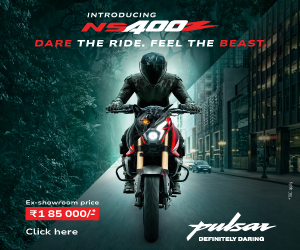 TVS takes an eco-friendly initiative with the new hybrid Scooty
TVS takes an eco-friendly initiative with the new hybrid Scooty
Words Bunny Punia Photography Adhish Alawani
Apart from the usual crop of Indian and imported motorcycles, the recently held Auto Expo in New Delhi also had a range of electric two-wheelers on display from close to a dozen manufacturers. But no matter how green these little wheels may be, there is always that mental block we have with their overall performance and of course, their operating range. However, TVS had something out of the box as an answer to these typical shortcomings – a lineup of sparkling white Scootys on display. They were being used as official bikes and interestingly, they had a unique graphic pattern on the body hinting at something, well, green. Curiosity leads to questions and hence, we decided to get hold of a few officials and check out the latest on offer.

TVS have developed a hybrid variant of their bestselling Scooty scooterette. The body is the same as the new Streak albeit with the new graphics. However, see the scooter from the left and you notice the smart casing of the electric motor that has been configured to run parallely with the same 87.8cc four-stroke engine powering the original model. Once astride the vehicle, you also notice four different operating models clearly marked out on the speedometer console along with the battery indicator. The four modes, namely Engine Only, Electric Only, Hybrid Power and Hybrid Economy can be chosen via a button (which on the regular model serves as the electric starter) on the right handlebar. Here is a brief look at what the different modes stand for:
Electric Only:
For short trips and zero fuel consumption. The scooter runs solely on the electric motor power.
Engine Only:
When the battery level is very low, the scooter runs on this mode.
Hybrid Economy:
Both sources run as per the programmed strategy. Initially, only the electric motor is in operation and once the scooter goes over a programmed speed, say 25km/h, the engine starts functioning as well.
Hybrid Power:
Both engine and electric together for better acceleration from standstill.
|
|
|
Further, to make the most efficient use of the energy, this hybrid system charges the battery when the brakes are applied and utilizes this power whenever required. In addition, this two-wheeler conserves energy when the vehicle is stationary at a traffic signal or at a standstill by stopping the power source. Brilliant! TVS claims to have achieved a 30 percent reduction in CO2 emissions, 25 percent reduction of HC + NOx and most importantly, a jump of around 30 percent in fuel economy.
During our short riding session around Pragati Maidan, we found the system to work perfectly. Although, with my weight (equivalent to two typical lightweight damsels), the electric motor took its own sweet time gathering pace. However, with a single college going female on board, the hybrid Scooty should perform very well. The parallel system is being fine tuned further and though no pricing has been disclosed, we expect a premium of around Rs 10k on the base sticker price. At this price, you get the best of both worlds – low fuel consumption and lesser emissions while retaining the same performance.




 The Pulsar 220 Streetfighter is Bajaj’s latest offering at the altar of speed. Pure, unadulterated speed
The Pulsar 220 Streetfighter is Bajaj’s latest offering at the altar of speed. Pure, unadulterated speed 




 Getaway trips are a bikerÕs delight as they rejuvenate you. Here are a few pointers that will help you make a long trip safe and memorable
Getaway trips are a bikerÕs delight as they rejuvenate you. Here are a few pointers that will help you make a long trip safe and memorable 














 Boasting of true American character, Confederate Motorcycle Company redefines the laws of motorcycle building by creating rebellious bikes
Boasting of true American character, Confederate Motorcycle Company redefines the laws of motorcycle building by creating rebellious bikes 




 The smallest Honda motorcycle yet is all set to create the maximum winds of change for the Japanese giant in India reckons
The smallest Honda motorcycle yet is all set to create the maximum winds of change for the Japanese giant in India reckons 




